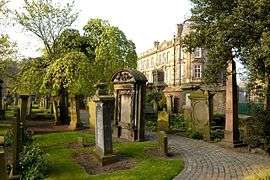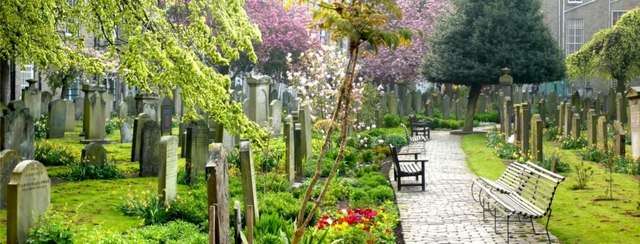The Howff

The Howff is a burial ground in the city of Dundee, Scotland. Established in 1564, it has one of the most important collections of tombstones in Scotland, and is protected as a category A listed building.[1]
History
The land of the burial ground was part of the Franciscan (Greyfriars) Monastery until the Scottish Reformation. In 1564 Mary, Queen of Scots granted the land to the burgh of Dundee, for use as a burial ground. It was used for meetings by the Dundee Incorporated Trades, and subsequently became known as The Howff, from the Scots word howff meaning a meeting place. Meetings at The Howff ceased in 1776.[1] The last burial took place in 1857. The walls along the west side date from 1601.[2]
Burials
Burials at The Howff include:
- David Lindsay, 1st Earl of Crawford (c.1360-1407), interred in the now destroyed pre-reformation Greyfriars kirk. [3]
- James Chalmers (1782–1853), inventor of the adhesive postage stamp
- John Glas (1695–1773), clergyman and founder of the Glasite movement
- George Duncan (politician)
References
- 1 2 "The Howff: Listed Building Report". Historic Scotland. Retrieved 2011-11-03.
- ↑ "The Howff". CANMORE. Royal Commission on the Ancient and Historical Monuments of Scotland. Retrieved 4 November 2011.
- ↑ James Balfour Paul, Scots Peerage, vol iii, p. 17. Edinburgh 1904
External links
 Media related to The Howff at Wikimedia Commons
Media related to The Howff at Wikimedia Commons

Coordinates: 56°27′41″N 2°58′22″W / 56.4615°N 2.9727°W